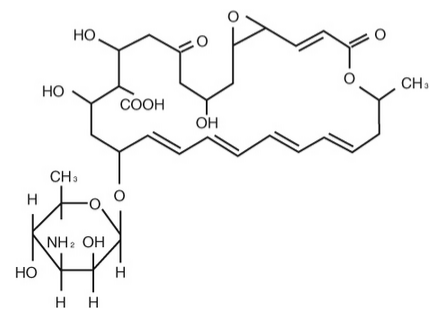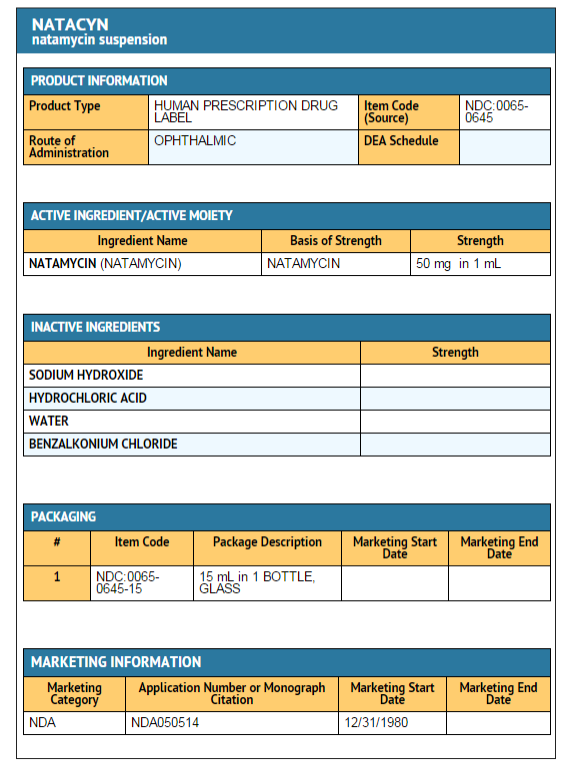Natamycin
Editor-In-Chief: C. Michael Gibson, M.S., M.D. [1]; Associate Editor(s)-in-Chief: Stefano Giannoni [2]
Disclaimer
WikiDoc MAKES NO GUARANTEE OF VALIDITY. WikiDoc is not a professional health care provider, nor is it a suitable replacement for a licensed healthcare provider. WikiDoc is intended to be an educational tool, not a tool for any form of healthcare delivery. The educational content on WikiDoc drug pages is based upon the FDA package insert, National Library of Medicine content and practice guidelines / consensus statements. WikiDoc does not promote the administration of any medication or device that is not consistent with its labeling. Please read our full disclaimer here.
Overview
Natamycin is an antifungal that is FDA approved for the treatment of fungal blepharitis, conjunctivitis, and keratitis caused by susceptible organisms including Fusarium solani keratitis.. Common adverse reactions include {{{adverseReactions}}}.
Adult Indications and Dosage
FDA-Labeled Indications and Dosage (Adult)
There is limited information regarding Natamycin FDA-Labeled Indications and Dosage (Adult) in the drug label.
Off-Label Use and Dosage (Adult)
Guideline-Supported Use
There is limited information regarding Off-Label Guideline-Supported Use of Natamycin in adult patients.
Non–Guideline-Supported Use
There is limited information regarding Off-Label Non–Guideline-Supported Use of Natamycin in adult patients.
Pediatric Indications and Dosage
FDA-Labeled Indications and Dosage (Pediatric)
There is limited information regarding Natamycin FDA-Labeled Indications and Dosage (Pediatric) in the drug label.
Off-Label Use and Dosage (Pediatric)
Guideline-Supported Use
There is limited information regarding Off-Label Guideline-Supported Use of Natamycin in pediatric patients.
Non–Guideline-Supported Use
There is limited information regarding Off-Label Non–Guideline-Supported Use of Natamycin in pediatric patients.
Contraindications
- Contraindicated in individuals with a history of hypersensitivity to any of its components.
Warnings
FOR TOPICAL OPHTHALMIC USE ONLY — NOT FOR INJECTION. Failure of improvement of keratitis following 7-10 days of administration of the drug suggests that the infection may be caused by a microorganism not susceptible to natamycin.
Continuation of therapy should be based on clinical re-evaluation and additional laboratory studies.
Adherence of the suspension to areas of epithelial ulceration or retention of the suspension in the fornices occurs regularly. Use only if the container is undamaged.
Adverse Reactions
Clinical Trials Experience
The following events have been identified during post-marketing use of NATACYN® in clinical practice. Because they are reported voluntarily from a population of unknown size, estimates of frequency cannot be made. The events, which have been chosen for inclusion due to their seriousness, frequency of reporting, possible causal connection to NATACYN®, or a combination of these factors include: allergic reaction, change in vision, chest pain, corneal opacity, dyspnea, eye discomfort, eye edema, eye hyperemia, eye irritation, eye pain, foreign body sensation, parethesia, and tearing.
Postmarketing Experience
There is limited information regarding Natamycin Postmarketing Experience in the drug label.
Drug Interactions
There is limited information regarding Natamycin Drug Interactions in the drug label.
Use in Specific Populations
Pregnancy
Pregnancy Category (FDA): C
Animal reproduction studies have not been conducted with natamycin. It is also not known whether natamycin can cause fetal harm when administered to a pregnant woman or can affect reproduction capacity. NATACYN® (natamycin ophthalmic suspension) 5% should be given to a pregnant woman only if clearly needed.
Pregnancy Category (AUS):
There is no Australian Drug Evaluation Committee (ADEC) guidance on usage of Natamycin in women who are pregnant.
Labor and Delivery
There is no FDA guidance on use of Natamycin during labor and delivery.
Nursing Mothers
It is not known whether these drugs are excreted in human milk. Because many drugs are excreted in human milk, caution should be exercised when natamycin is administered to a nursing woman.
Pediatric Use
Safety and effectiveness in pediatric patients have not been established.
Geriatic Use
No overall differences in safety or effectiveness have been observed between elderly and younger patients.
Gender
There is no FDA guidance on the use of Natamycin with respect to specific gender populations.
Race
There is no FDA guidance on the use of Natamycin with respect to specific racial populations.
Renal Impairment
There is no FDA guidance on the use of Natamycin in patients with renal impairment.
Hepatic Impairment
There is no FDA guidance on the use of Natamycin in patients with hepatic impairment.
Females of Reproductive Potential and Males
There is no FDA guidance on the use of Natamycin in women of reproductive potentials and males.
Immunocompromised Patients
There is no FDA guidance one the use of Natamycin in patients who are immunocompromised.
Administration and Monitoring
Administration
There is limited information regarding Natamycin Administration in the drug label.
Monitoring
There is limited information regarding Natamycin Monitoring in the drug label.
IV Compatibility
There is limited information regarding the compatibility of Natamycin and IV administrations.
Overdosage
There is limited information regarding Natamycin overdosage. If you suspect drug poisoning or overdose, please contact the National Poison Help hotline (1-800-222-1222) immediately.
Pharmacology
There is limited information regarding Natamycin Pharmacology in the drug label.
Mechanism of Action
Natamycin is a tetraene polyene antibiotic derived from Streptomyces natalensis. It possesses in vitro activity against a variety of yeast and filamentous fungi, including Candida, Aspergillus, Cephalosporium, Fusarium and Penicillium. The mechanism of action appears to be through binding of the molecule to the sterol moiety of the fungal cell membrane. The polyenesterol complex alters the permeability of the membrane to produce depletion of essential cellular constituents. Although the activity against fungi is dose-related, natamycin is predominantly fungicidal. Natamycin is not effective in vitro against gram-positive or gram-negative bacteria.
Structure
- Natamycin ophthalmic suspension) 5% is a sterile, antifungal drug for topical ophthalmic administration.
- Each mL of the suspension contains:
- Active: natamycin 5% (50 mg).
- Preservative: benzalkonium chloride 0.02%.
- Inactive: sodium hydroxide and/or hydrochloric acid (neutralized to adjust the pH), purified water.
- The active ingredient is represented by the chemical structure:
- Established name: Natamycin

- Molecular Formula: C33H47NO13
- Molecular Weight: 665.73
- Chemical name: Stereoisomer of 22-[(3-amino-3,6-dideoxy- β-D-mannopyranosyl)oxy]-1,3,26- trihydroxy-12- methyl-10-oxo-6,11,28- trioxatricyclo[22.3.1.05,7] octacosa-8,14,16,18,20-pentaene-25- carboxylic acid.
- Other: Pimaricin
- The pH range is 5.0 - 7.5.
Pharmacodynamics
There is limited information regarding Natamycin Pharmacodynamics in the drug label.
Pharmacokinetics
Topical administration appears to produce effective concentrations of natamycin within the corneal stroma but not in intraocular fluid. Systemic absorption should not be expected following topical administration of NATACYN® (natamycin ophthalmic suspension) 5%. As with other polyene antibiotics, absorption from the gastrointestinal tract is very poor. Studies in rabbits receiving topical natamycin revealed no measurable compound in the aqueous humor or sera, but the sensitivity of the measurement was no greater than 2 mg/mL.
Nonclinical Toxicology
There have been no long term studies done using natamycin in animals to evaluate carcinogenesis, mutagenesis, or impairment of fertility.
Clinical Studies
There is limited information regarding Natamycin Clinical Studies in the drug label.
How Supplied
- Natamycin ophthalmic suspension 5% is a 15mL fill packaged in a 15mL amber glass bottle with a black phenolic closure. A flint glass dropper with a red plastic closure and a black rubber bulb are packaged separately in a clear plastic blister with Tyvek backing.
NDC 0065-0645-15
Storage
- Store between 2-24°C (36-75°F).
- Do not freeze.
- Avoid exposure to light and excessive heat.
Images
Drug Images
{{#ask: Page Name::Natamycin |?Pill Name |?Drug Name |?Pill Ingred |?Pill Imprint |?Pill Dosage |?Pill Color |?Pill Shape |?Pill Size (mm) |?Pill Scoring |?NDC |?Drug Author |format=template |template=DrugPageImages |mainlabel=- |sort=Pill Name }}
Package and Label Display Panel

{{#ask: Label Page::Natamycin |?Label Name |format=template |template=DrugLabelImages |mainlabel=- |sort=Label Page }}
Patient Counseling Information
Do not touch dropper tip to any surface, as this may contaminate the suspension. Patients should be advised not to wear contact lenses if they have signs and symptoms of fungal blepharitis, conjunctivitis, and keratitis.
Precautions with Alcohol
Alcohol-Natamycin interaction has not been established. Talk to your doctor about the effects of taking alcohol with this medication.
Brand Names
- Natacyn
Look-Alike Drug Names
There is limited information regarding Natamycin Look-Alike Drug Names in the drug label.
Drug Shortage Status
Price
References
The contents of this FDA label are provided by the National Library of Medicine.
| File:Natamycin.svg | |
| Clinical data | |
|---|---|
| ATC code | |
| Identifiers | |
| CAS Number | |
| PubChem CID | |
| DrugBank | |
| E number | {{#property:P628}} |
| ECHA InfoCard | {{#property:P2566}}Lua error in Module:EditAtWikidata at line 36: attempt to index field 'wikibase' (a nil value). |
| Chemical and physical data | |
| Formula | C33H47NO13 |
| Molar mass | 665.725 g/mol |
Natamycin, also known as pimaricin, is a naturally occurring antimicrobial agent produced by the bacterium Streptomyces natalensis. It is a macrolide polyene antifungal drug used to treat fungal keratitis. It is especially effective against Aspergillus and Fusarium corneal infections.
Uses
In foods
It is used in the food industry as a preservative to inhibit fungal growth on cheese and other food. It may be applied in a liquid spray or in powdered form on whole, shredded, or soft cheese, or applied on or in the wax covering of some cheeses.
As a food additive, it has E number E235.
Medical
Natamycin is used to treat fungal infections, including Candida, Aspergillus, Cephalosporium, Fusarium and Penicillium. It is applied as a cream, in eyedrops, or (for oral infections) in a lozenge. Natamycin shows negligible absorption into the body when administered in these ways. When taken orally, little or none is absorbed from the gastrointestinal tract, making it inappropriate for systemic infections.[1]
Safety
Natamycin lacks acute toxicity. In animal studies, the lowest LD50 found was 450 mg/kg. In rats, the LD50 is ≥2300 mg/kg, and doses of 500 mg/kg/day over 2 years caused no detectable differences in survival rate, growth, or incidence of tumors. The metabolites of natamycin also lack toxicity. The breakdown products of natamycin under various storage conditions may have a lower LD50 than natamycin, but in all cases the numbers are quite high. In humans, a dose of 500 mg/kg/day repeated over multiple days caused nausea, vomiting, and diarrhea.[2]
There is no evidence that natamycin, at either pharmacological levels or levels encountered as a food additive, can harm normal intestinal flora, but definitive research may not be available.[2]
External links
References
- ↑ Sweetman, S. (2004). Martindale: The Complete Drug Reference
- ↑ 2.0 2.1 Mattia, A. et al. SAFETY EVALUATION OF CERTAIN FOOD ADDITIVES AND CONTAMINANTS: NATAMYCIN (PIMARICIN). WHO Food Additives Series #48.
Template:Antidiarrheals, intestinal anti-inflammatory/anti-infective agents
cs:Natamycin de:Natamycin nl:Natamycine Template:WikiDoc Sources
- Pages with script errors
- Pages with broken file links
- E number from Wikidata
- ECHA InfoCard ID from Wikidata
- Articles without EBI source
- Chemical pages without ChemSpiderID
- Articles without KEGG source
- Articles without InChI source
- Articles without UNII source
- Drugs with no legal status
- Articles containing unverified chemical infoboxes
- Antifungals
- Preservatives
- Antimicrobial stubs